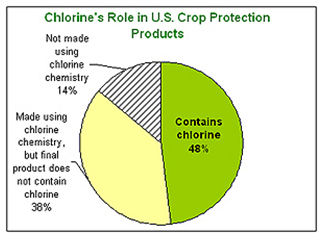A Bountiful Harvest
Peaches, tomatoes, corn on the cob and leafy greens—the fruits of the year’s harvest—delight the palate as they nourish the body. Our access to tasty, nutritious and affordable foods is due in no small part to the modern farmer’s use of crop protection products. Crop protection products include herbicides to help control weeds, pesticides to help reduce crop loss by insects, and fungicides to help control crop-damaging fungi. These products improve the quality and yield of crops and reduce crop losses and soil erosion.
Chlorine chemistry plays a vital role in the production of 89 percent of crop protection products used in the United States. The pie chart below illustrates that 48 percent of these products have chlorine in the final product, and an additional 38 percent are produced using chlorine chemistry.

Crop Protection: A Little Chlorine Goes a Long Way
Less than five percent of the chlorine consumed in the United States and Canada is used to manufacture crop protection products, but a little chlorine goes a long way in helping to protect crops. Without safe and effective crop protection products, farmers would be forced to use more expensive means to maintain the current high level of agricultural production. Those costs would be passed on to the consumer. According to a 2006 study, in the absence of chlorine-based crop protection products, annual food costs for U.S. and Canadian consumers would increase by $15 billion, approximately the cost of eight new space shuttles!
Historical Crop Destruction
Crop-destroying insects have exasperated farmers for centuries. In the late 1800s, the snout beetle, Anthonomous grandis grandis, known as the Cotton Boll Weevil, migrated to the United States from Mexico, spreading misery among Southern cotton farmers as it devastated that important crop. The fungus Phytophthora infestans was responsible for the devastating Irish Potato Famine of the mid-1800s. Potatoes rotted in the fields to the frustration of farmers, who had no means to alleviate the blight. Historians estimate 12 percent of Ireland’s population, over one million people, died as a result of this fungal attack on the Irish potato crop.
Herbicides: A Case Study
Herbicides are crop protection products that destroy weeds. Weeds compete with crops for water and soil nutrients, reducing crop yields; weeds must be controlled for efficient crop production.
Historically, farmers prepared land for crops by turning over the upper layers of soil, or “tilling” the soil using plows. One of the functions of tilling is to remove weeds. In loosening soil, however, tilling leaves soil vulnerable to erosion. Valuable soil is washed away during storms, depleting farmland and compromising the quality of receiving waterways.
Herbicides help reduce the need for frequent tilling, saving soil and tractor fuel. Weed-pulling by hand, another alternative to tilling, is prohibitively expensive because it is so labor-intensive.